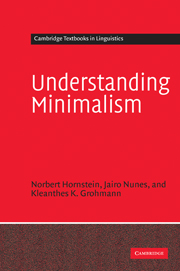Book contents
- Frontmatter
- Contents
- Preface
- List of abbreviations
- 1 The minimalist project
- 2 Some architectural issues in a minimalist setting
- 3 Theta domains
- 4 Case domains
- 5 Movement and minimality effects
- 6 Phrase structure
- 7 Linearization
- 8 Binding Theory
- 9 Feature interpretability and feature checking
- 10 Derivational economy
- Glossary of minimalist definitions
- References
- Language index
- Name index
- Subject index
7 - Linearization
Published online by Cambridge University Press: 05 June 2012
- Frontmatter
- Contents
- Preface
- List of abbreviations
- 1 The minimalist project
- 2 Some architectural issues in a minimalist setting
- 3 Theta domains
- 4 Case domains
- 5 Movement and minimality effects
- 6 Phrase structure
- 7 Linearization
- 8 Binding Theory
- 9 Feature interpretability and feature checking
- 10 Derivational economy
- Glossary of minimalist definitions
- References
- Language index
- Name index
- Subject index
Summary
Introduction
To this point we have left the issue of linear word order aside and have concentrated exclusively on structural properties. This focus reflects the widely accepted and long-held belief within the generative tradition that grammatical operations are structure-dependent and do not (by and large) exploit linear dependencies. The study of grammar has been, until very recently, the study of hierarchical dependencies and their alterations. Linear properties were taken to be of secondary interest (if of any interest at all) to grammarians.
Under this traditional view, English and Japanese VPs, for instance, are structurally the same (their dominance and sisterhood relations are identical), their difference residing only in the order of constituents, with the verb preceding its object in English, but following it in Japanese, as respectively represented in (1) and (2).
(1) Norbert [VP ate bagels]
(2) Japanese
Jiro-ga [VP sushi-o tabeta]
Jiro-NOM sushi-ACC ate
‘Jiro ate sushi.’
The type of superficial difference illustrated in (1) and (2) was captured by directionality parameters that stated the order between heads and complements and heads and specifiers for the constituents of a given language. In the case at hand, for instance, English was taken to set the option VO and Japanese was taken to set the option OV for the parameter regarding the order between the verb and its complement.
In this chapter, we'll address the question of how to deal with linear order within minimalism, based on Kayne's (1994) influential work, which takes word order to piggyback on hierarchical structure.
- Type
- Chapter
- Information
- Understanding Minimalism , pp. 218 - 246Publisher: Cambridge University PressPrint publication year: 2005



